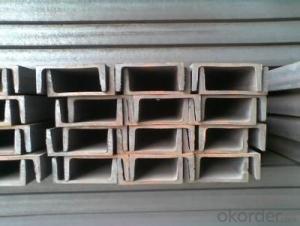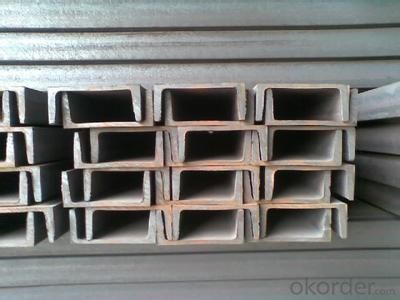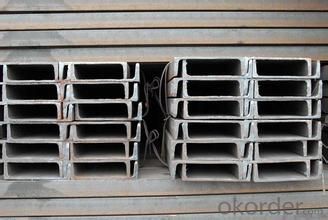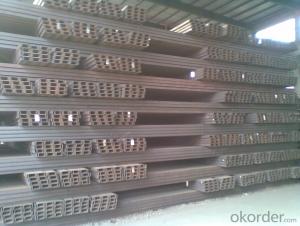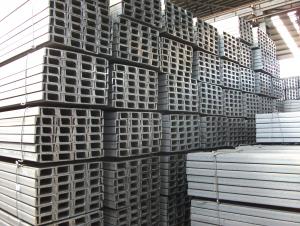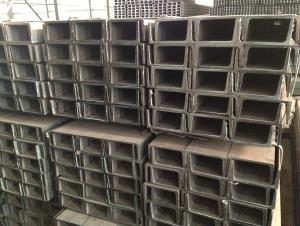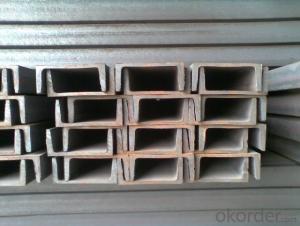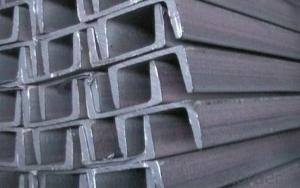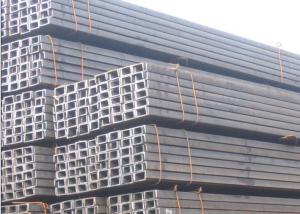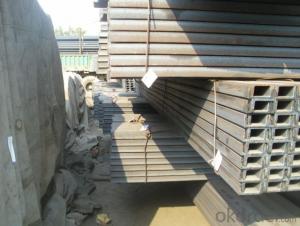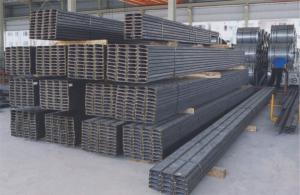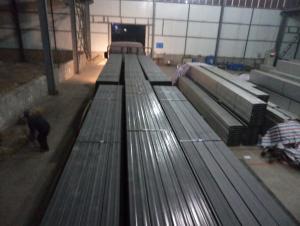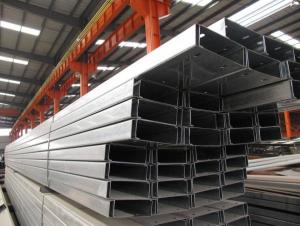Q235 Carbon Steel Channel
- Loading Port:
- China Main Port
- Payment Terms:
- TT or LC
- Min Order Qty:
- -
- Supply Capability:
- -
OKorder Service Pledge
OKorder Financial Service
You Might Also Like
Product Description:
OKorder is offering Q235 Carbon Steel Channel at great prices with worldwide shipping. Our supplier is a world-class manufacturer of steel, with our products utilized the world over. OKorder annually supplies products to European, North American and Asian markets. We provide quotations within 24 hours of receiving an inquiry and guarantee competitive prices.
Product Applications:
Q235 Carbon Steel Channel are ideal for structural applications and are widely used in the construction of buildings and bridges, and the manufacturing, petrochemical, and transportation industries.
Product Advantages:
OKorder's Q235 Carbon Steel Channel are durable, strong, and resist corrosion.
Main Product Features:
· Premium quality
· Prompt delivery & seaworthy packing (30 days after receiving deposit)
· Corrosion resistance
· Can be recycled and reused
· Mill test certification
· Professional Service
· Competitive pricing
Product Specifications:
Manufacture: Hot rolled
Grade: Q195 – 235
Certificates: ISO, SGS, BV, CIQ
Length: 6m – 12m, as per customer request
Packaging: Export packing, nude packing, bundled
Chinese Standard (H*W*T) | Weight (Kg/m) | 6m (pcs/ton) | Light I (H*W*T) | Weight (Kg/m) | 6m (pcs/ton) | Light II (H*W*T) | Weight (Kg/m) | 6M |
100*68*4.5 | 11.261 | 14.8 | 100*66*4.3 | 10.13 | 16.4 | 100*64*4 | 8.45 | 19.7 |
120*74*5.0 | 13.987 | 11.9 | 120*72*4.8 | 12.59 | 13.2 | 120*70*4.5 | 10.49 | 15.8 |
140*80*5.5 | 16.89 | 9.8 | 140*78*5.3 | 15.2 | 10.9 | 140*76*5 | 12.67 | 13.1 |
160*88*6 | 20.513 | 8.1 | 160*86*5.8 | 18.46 | 9 | 160*84*5.5 | 15.38 | 10.8 |
180*94*6.5 | 24.143 | 6.9 | 180*92*6.3 | 21.73 | 7.6 | 180*90*6 | 18.11 | 9.2 |
200*100*7 | 27.929 | 5.9 | 200*98*6.8 | 25.14 | 6.6 | 200*96*6.5 | 20.95 | 7.9 |
220*110*7.5 | 33.07 | 5 | 220*108*7.3 | 29.76 | 5.6 | 220*106*7 | 24.8 | 6.7 |
250*116*8 | 38.105 | 4.3 | 250*114*7.8 | 34.29 | 4.8 | 250*112*7.5 | 28.58 | 5.8 |
280*122*8.5 | 43.492 | 3.8 | 280*120*8.2 | 39.14 | 4.2 | 280*120*8 | 36.97 | 4.5 |
300*126*9 | 48.084 | 3.4 | 300*124*9.2 | 43.28 | 3.8 | 300*124*8.5 | 40.87 | 4 |
320*130*9.5 | 52.717 | 3.1 | 320*127*9.2 | 48.5 | 3.4 | |||
360*136*10 | 60.037 | 2.7 | 360*132*9.5 | 55.23 | 3 |
FAQ:
Q1: Why buy Materials & Equipment from OKorder.com?
A1: All products offered byOKorder.com are carefully selected from China's most reliable manufacturing enterprises. Through its ISO certifications, OKorder.com adheres to the highest standards and a commitment to supply chain safety and customer satisfaction.
Q2: How do we guarantee the quality of our products?
A2: We have established an advanced quality management system which conducts strict quality tests at every step, from raw materials to the final product. At the same time, we provide extensive follow-up service assurances as required.
Q3: How soon can we receive the product after purchase?
A3: Within three days of placing an order, we will begin production. The specific shipping date is dependent upon international and government factors, but is typically 7 to 10 workdays.
Q4: What makes stainless steel stainless?
A4: Stainless steel must contain at least 10.5 % chromium. It is this element that reacts with the oxygen in the air to form a complex chrome-oxide surface layer that is invisible but strong enough to prevent further oxygen from "staining" (rusting) the surface. Higher levels of chromium and the addition of other alloying elements such as nickel and molybdenum enhance this surface layer and improve the corrosion resistance of the stainless material.
Q5: Can stainless steel rust?
A5: Stainless does not "rust" as you think of regular steel rusting with a red oxide on the surface that flakes off. If you see red rust it is probably due to some iron particles that have contaminated the surface of the stainless steel and it is these iron particles that are rusting. Look at the source of the rusting and see if you can remove it from the surface.
Images:
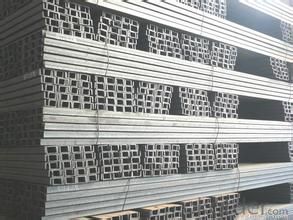

- Q: What are the different methods for designing steel channels for high wind loads?
- There are several methods for designing steel channels for high wind loads. One common approach is to use the Load and Resistance Factor Design (LRFD) method, which takes into account the applied loads, such as wind pressure, and the resistance of the steel channel. Another method is the Allowable Stress Design (ASD) method, which uses a factor of safety to determine the maximum permissible stress in the steel channel. Additionally, computer-aided design (CAD) software can be utilized to analyze and optimize the structural performance of steel channels under high wind loads.
- Q: Are steel channels suitable for use in agricultural structures?
- Agricultural structures can indeed make use of steel channels. Steel itself is a robust and enduring material, capable of enduring the often harsh environmental conditions that are typically present in agricultural settings. Not only is it resistant to pests, rot, and decay, but it also offers a long-lasting solution for constructing buildings such as barns, storage sheds, and livestock shelters. Steel channels prove particularly advantageous in agricultural structures, as they not only provide essential structural support but can also be effortlessly incorporated into the building's design. Moreover, steel possesses fire-resistant properties, a critical aspect to consider when handling the flammable materials commonly found on farms. Ultimately, the utilization of steel channels in agricultural structures ensures stability, durability, and safety.
- Q: Can steel channels be used for window frames?
- Yes, steel channels can be used for window frames. Steel channels are strong and durable, making them an excellent choice for supporting the weight of window glass and providing structural integrity to the frame. They can be easily fabricated and welded to create custom window frames of various sizes and shapes. Additionally, steel channels have a high resistance to corrosion, which ensures the longevity and maintenance-free nature of the window frames. However, it is important to consider the thermal conductivity of steel, as it can result in heat loss or gain through the frame. To overcome this, thermal breaks or insulation can be incorporated into the design of the window frame. Overall, steel channels offer a reliable and versatile option for window frames in both residential and commercial applications.
- Q: How do steel channels perform in terms of acoustic insulation?
- Steel channels typically do not perform well in terms of acoustic insulation. Due to their rigid and dense nature, steel channels tend to transmit sound vibrations rather than absorb or dampen them. For effective acoustic insulation, alternative materials with better soundproofing properties such as acoustic foam or insulation panels are often recommended.
- Q: No. 20 b one meter with multiple channel
- Each physical channel is the standard provisions of 20b# weight 25.777 kg, but the actual weight is not up to a difference.
- Q: Six meters long, standard 10 channel steel, theoretical weight
- The finished channel steel is delivered by hot forming, normalizing or hot rolling. The specifications are expressed in millimeters of height (H) * leg width (b) * waist thickness (d), such as 100*48*5.3, which means waist height is 100 mm, leg width is 48 mm, waist thickness is 5.3 mm channel, or 10# channel steel. The same height of the channel, if there are several different leg width and waist thickness, also need to add a, B, C on the right side of the model to distinguish, such as 25#a, 25#b, 25#c and so on.
- Q: Can steel channels be used for raised flooring systems?
- Yes, steel channels can be used for raised flooring systems. Steel channels are durable and strong, making them an ideal choice for supporting raised floors. The channels can be laid out in a grid pattern and provide a stable base for the raised floor panels. Additionally, steel channels can easily support heavy loads, making them suitable for areas with high foot traffic or equipment installations. Their corrosion-resistant properties also make them a long-lasting option for raised flooring systems.
- Q: How are steel channels connected to other structural members?
- Steel channels can be connected to other structural members through various methods such as welding, bolting, or using mechanical connectors. This ensures a secure and stable connection between the steel channels and the other structural components, enabling them to function together as a unified system.
- Q: What is the difference between C steel, U steel and channel steel?
- U type steel (hot rolled U steel mine roadway Name: U steel) is English steel like the letter "U" with a cross section, sometimes with a cross section of Japanese letters "better" shape. Main features: large pressure, long support time, easy installation, not easy to deformation and so on. Main uses: mainly used in mine roadway, roadway support, and two times of the tunnel supporting etc.. As the main shape steel for the retractable metal support of tunnel, U steel is widely used at home and abroad.
- Q: Can steel channels be used for framing walls?
- Yes, steel channels can be used for framing walls. They provide a strong and durable framework for constructing walls and can be an excellent alternative to traditional wood framing. Steel channels offer superior strength and resistance to warping, shrinking, and termite damage. Additionally, they are lightweight and easy to work with, making them a popular choice in many construction projects.
Send your message to us
Q235 Carbon Steel Channel
- Loading Port:
- China Main Port
- Payment Terms:
- TT or LC
- Min Order Qty:
- -
- Supply Capability:
- -
OKorder Service Pledge
OKorder Financial Service
Similar products
Hot products
Hot Searches
Related keywords
